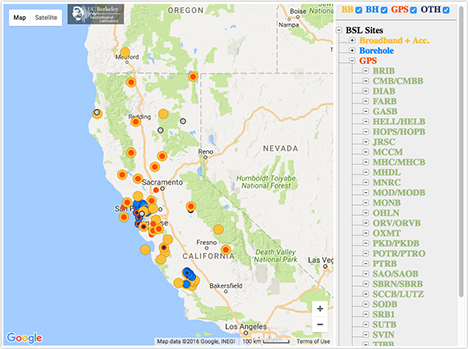Berkeley Digital Seismic Network Overview


The Berkeley Digital Seismic Network (BDSN) is a regional network of very broadband and strong motion seismic stations spanning Northern California and linked to UC Berkeley through continuous telemetry. The network is designed to monitor regional seismic activity as well as to provide high quality data for research in regional and global broadband seismology. The network currently consists of 40 stations, including an ocean-bottom seismometer in Monterey Bay (MOBB). We take particular pride in high quality installations, which often involve lengthy searches for appropriate sites away from sources of low-frequency noise as well as continuous improvements in installation procedures and careful monitoring of noise conditions and problems.
BDSN news and archived information about BDSN data
BDSN news and archived information about data from the BDSN is available at the NCEDC blog.
Special Projects of the BDSN
MOBB is a long-term seafloor broadband station installed and operated as a first step towards extending the on-shore broadband seismic network in Northern California to the seaside of the North-America/Pacific plate boundary, providing better azimuthal coverage for regional earthquake and structure studies. (Read more about MOBB...)
Network Code
BK (also includes the BBN [NHFN and MPBO], as well as MOBB)
Typical Station Equipment
The individual station pages, reachable through the BDSN station table or the interactive networks map, list current instrumentation at each site.
Thirty-six BDSN sites are equipped with three-component broadband seismometers and strong-motion accelerometers, and with 24- or 26-bit digital data acquisition systems or data loggers. Three sites (BL88, RFSB and SCCB) consist of a strong-motion accelerometer and a 24-bit digital data logger. The ocean-bottom station MOBB is equipped with a three component broadband seismometer with integrated digitizer and a differential pressure gauge (DPG).Most BDSN stations have Streckeisen STS-1 or STS-2 three-component broadband sensors (Wielandt and Streckeisen, 1982; Wielandt and Steim, 1986).
Data from all BDSN stations are transmitted to UC Berkeley using continuous telemetry, including the ocean-bottom site, MOBB. In order to avoid data loss during utility disruptions, each site has batteries to supply power for three days. The combination of high-dynamic range sensors and digital data loggers ensures that the BDSN has the capability to record the full range of earthquake motion required for source and structure studies.
Typical Recorded Channels
| Sensor | Channel | Rate (sps) | Mode | FIR |
| BB | VH? | 0.1 | C | Ac |
| BB | LH? | 1 | C | Ac |
| BB | BH? | 40 | C | Ac |
| BB | HH? | 100 | C | Ca |
| SM | LN? | 1 | C | Ac |
| SM | BN? | 20/40 | C | Ac |
| SM | HN? | 100/200 | C | Ca/Ac |
Network State of Health
As part of routine quality control, the results of continuously performed power spectral density (PSD) analyses are available on the Internet (http://www.ncedc.org/ncedc/PDF/). State of health plots for each station are available on each individual station page.
Station and Channel Information
- Table of BDSN stations
- BK Information Directory, including
- List of station locations
- List of available channels
- Instrument Response
- View digital seismograms
Data access
Waveform data from the BK network are available in SEED format at the Northern California Earthquake Data Center.
Several tools provide access to SEED format data at the NCEDC, both in terms of querying the archives and allowing data requests.
The IRIS DMC also archives data for the BDSN station CMB.
Reports and Publications
The Berkeley Seismological Lab Annual Report contains more detailed information on the BDSN and the history of the network.
Collaborations
Several stations of the BDSN are operated cooperatively by the Berkeley Seismological Laboratory in collaboration with:
- BRIB - Lawrence Livermore National Laboratory
- CMB - IRIS Consortium and United States National Seismic Network of the USGS.
- JRSC - Stanford University - Geophysics Department.
- KCC - UC Santa Cruz.
- HUMO - United States National Seismic Network of the USGS.
- MOD - United States National Seismic Network of the USGS.
- SAO - United States National Seismic Network of the USGS.
- WDC - United States National Seismic Network of the USGS.
